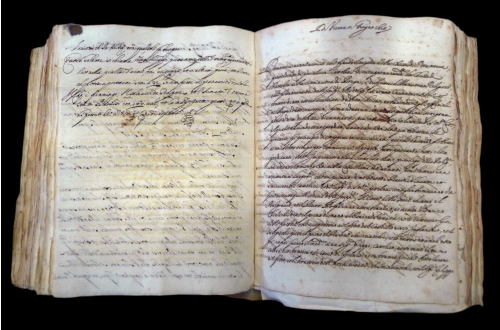Irish research finds lost news world in Medici Archives
Published in Issue 1 (January/February 2020), News, Volume 28Handwritten news was exchanged across Europe in what was a lucrative and powerful network.
By Eoin Hahessy
Irish research has found an entirely lost news environment in the Medici papers at Florence’s State Archives. In the sixteenth and seventeenth centuries early modern Europe communicated by handwritten newsletters, many of which had been forgotten until now. Brendan Dooley, Professor of Renaissance Studies at University College Cork, has uncovered some 200 volumes of manuscript newsletters in the vast vaults of the State Archives in Florence, where the Medici family papers are located. For four centuries these manuscript newsletters remained unused and unread, and they are revealing an information network stretching from Florence to Warsaw, from Paris to Madrid, from the Netherlands to Britain, Ireland and the American colonies. This handwritten news was exchanged across Europe in what was a lucrative and powerful network.
Irish history is revealed in the manuscript newsletters. One from Venice dated 19 March 1588 carried news about the Spanish Armada setting sail:
‘… It was heard from Lisbon that the armada was ready with 140 or more sailing ships, and 8 months of provisions; and it was said that it would set sail toward the end of this month with 17,000 combat soldiers and 8,000 sailors. It was not known where it would be directed—some said it would go to join the duke of Parma, while others said it would sail for Ireland.’

Above: Vienna newsletter of 1618, announcing the spark that ignited the Thirty Years’ War. (Florence State Archive)
A 1606 newsletter from Spain reports on a large number of Irish emigrating to Galicia in order to flee an edict against Catholics published in Ireland. A 1607 newsletter from Brussels reports a tip-off from Paris about the arrival in France of Hugh O’Neill, earl of Tyrone, who was escaping from Ireland and trying to reach Spain.
In 1648, handwritten newsletters around Europe contained plenty of news about Ireland, including reports in January and February regarding the progress of Owen Roe O’Neill’s forces up to the gates of Dublin, as well as tales of ill-paid English soldiers joining the Catholic Confederates for better treatment. Also in 1648 reports are circulating about Thomas Wentworth’s role in fomenting the Irish rebellion. By April Irish Protestants are reported to be threatening to abandon the country unless the English do more to protect them. In June of the same year, Giovanni Battista Rinuccini, the papal nuncio in Ireland, is presenting Pope Innocent X with standards taken by the Irish Catholic Confederates in recent battles.
European news is also widely reported, with one Vienna newsletter of 2 June 1618 announcing the spark that ignited the Thirty Years’ War:
‘Ulrich Chiazichi grabbed Baron Slavata and threw him out of the windows facing the castle moat … and Smergischi seized Baron Sminciaschi and threw this one out too, and then they did the same thing with secretary Philip, a Catholic, and although the first drop is more than 28½ Florentine braccia, and another 14 braccia because they rolled down the bank and were shot at with harquebuses.’
Sources used by news writers included soldiers’ battlefield accounts, diplomats’ reports, people’s personal letters, rulers’ decrees and more. Some large shops subscribed to numerous newsletters, then copied and redistributed these to their own subscribers. Once they arrived at their destination, they were shared among family members and even read aloud in the streets and squares.
Readers had to beware, because not all news could be trusted. Not only was astrological information treated as fact, but the Armada was said to have landed in England and King Henry IV of France was reported dead many times before his eventual assassination in 1610. Sightings of fabulous animals had to be taken with a grain of salt, as did reports of monstrously deformed humans. The further away a place was, and the less likely the news was to be checked, the more writers’ imaginations seemed to run wild.
Reading news was a skill, just as writing it was. And the success of the newsletters was proven by their wide distribution, as well as by their role in the development of newspapers. Beginning in Germany in 1605, newsletters came to be printed up for even wider distribution, and during the course of the seventeenth century the two types competed, at least in places where both could be found, with newspapers serving a broader public and newsletters a more élite one.
Professor Dooley’s team will be working closely with the State Archives in Florence, as well as the Medici Archive Project, a non-profit organisation based in Florence and New York, to implement a systematic extraction method for making sense of the whole mass of documentation and to connect the dots in an expanding pattern of exchanges. Recently Professor Dooley was awarded €1 million by the Irish Research Council to further this research.
Eoin Hahessy is the writer and director of Michael, they’ve shot them, a historical documentary that charted the impact of Ireland’s 1916 Easter Rising in Australia.
















